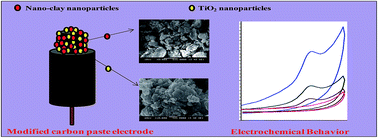Fabrication of a TiO2 and clay nanoparticle composite electrode as a sensor
Abstract
In the present study, a simple, selective, and sensitive electrochemical method for the determination of atorvastatin was proposed based on a composite electrode. The electrode was prepared using nanoclay and a carbon paste electrode, to which TiO2 nanoparticles were added to investigate the electrode behaviour towards atorvastatin detection. Cyclic voltammetric technique was used to investigate the behaviour of the carbon paste electrode, nanoclay-modified electrode, and TiO2 nanoparticle/nanoclay-modified carbon paste electrode for the oxidation of atorvastatin. It was observed that the TiO2 nanoparticle/nanoclay-modified carbon paste electrode had significant enhancement of about 5–10 times. Parameters such as number of electrons transferred, diffusion coefficient, and heterogeneous rate constant were calculated. A probable electrochemical reaction mechanism for atorvastatin was proposed. Limit of detection and quantification were calculated under the optimized conditions. It was found that the TiO2 nanoparticle/nanoclay-modified carbon paste electrode exhibited lower detection limit as compared the bare and nanoclay-modified electrode. For the analytical applications, pharmaceutical dose form and human urine sample analysis were performed. Various interferents were used to investigate the interference in the analytical application, and it was found that the proposed method could be well adopted for clinical trials and real sample analysis.



 Please wait while we load your content...
Please wait while we load your content...